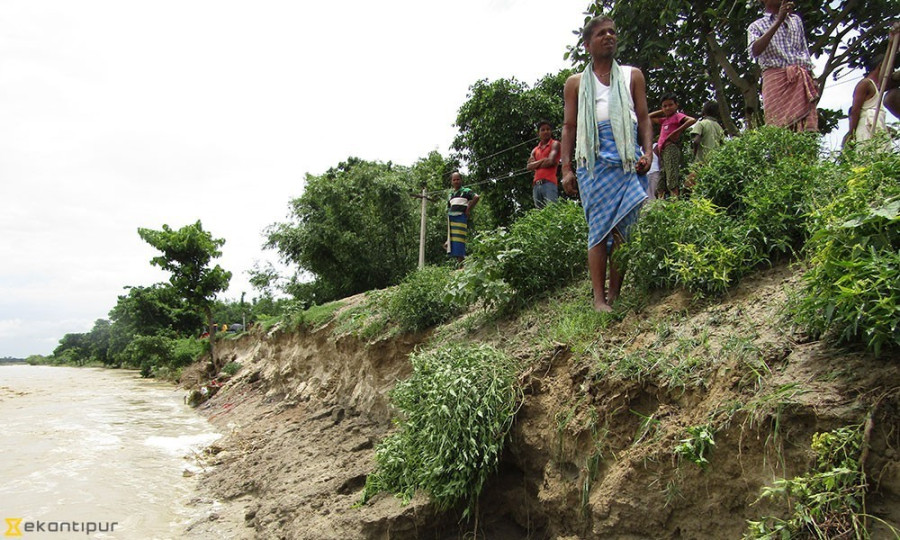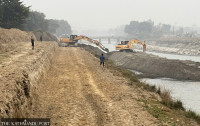National
People worry in disaster-prone Tarai villages as monsoon kicks in
Tilathi has long been vulnerable to floods from the Khado river during the monsoon.
Chandan Kumar Mandal
For Babu Narayan Mishra, a resident of Tilathi Koiladi Rural Municipality, Saptari, the monsoon floods are not new. For decades, the people of Tilathi and neighbouring villages have lived with the fear of waters from Koshi and Khado rivers gushing into their houses during the rainy season.
Whenever dark clouds start hovering over these villages, people like Mishra get worried.
“It has not rained heavily so far this monsoon. But with the gathering dark clouds above us, it seems like it’s going to rain today. We are worried about possible floods,” Mishra told the Post.
Tilathi has long been vulnerable to floods from the Khado river during the monsoon. Though an embankment was constructed last year to stop the river from spilling its banks, Mishra says the possibility of floods cannot be entirely ruled out.
“The threat of flood in Tilathi has gone down compared to other surrounding villages. But you never know in case of heavy rainfall. The waters from the Khado river could beach the embankment and flood our settlement,” Mishra said.
In 2017, over 150 houses in Tilathi, including Mishra’s, were inundated by the monsoon floods.
Villages like Belhi, Launiya, Sakharpura, Rampura Malhawaniya in Saptari are highly vulnerable to floods.
With the arrival of monsoon, the fear of floods looms over many low-lying areas across the Tarai region while landslides threaten many settlements in the Hill districts.
The monsoon entered a bit late this year with many parts of the country yet to receive rains. But weather officials say the monsoon activities will increase in the days to come.
Saturday’s isolated rainfall, including the heavy rainfall inside the Kathmandu Valley, which received 72mm rainfall in 24 hours, has hinted that the monsoon is gradually becoming active, Shanti Kadel, senior meteorologist at the Meteorological Forecasting Division, told the Post.
“There will be a surge in the monsoon activities across the country. With more rainfall incidents, there will parallel increase in hydro-meteorological disasters like floods, landslides and thunderstorms, among others,” he said.
Every year, water-induced disasters claim hundreds of lives across the country. Last year, various natural disasters including water-induced ones killed 455 people in various parts of the country, which witnessed an over 50 percent rise in disasters.
In 2017, floods in various Tarai districts had claimed more than 150 lives.
“Although we are unlikely to witness extreme rainfall in the next few days, there will not be longer dry spells anymore. There will not be extreme rainfall which is heavy downpour within a few hours, but there will be heavy rainfall capable of triggering floods and landslides,” Kadel said.
“People living along the river in the plains should be prepared for possible floods and those living in the Hill region should remain alert for landslides.”
As part of preparedness for disasters, Kadel said local communities should identify safer places and stay informed about weather conditions through available means.
From 2017 floods, the Department of Hydrology and Meteorology has started issuing regular updates and bulletins on water levels in various major rivers of the country.
The department has also started giving weather prediction for three days and sending SMS alerts whenever water levels of rivers cross the danger mark.
For this monsoon, the department has developed similar response plan.
The Home Ministry also has similar action plan which mostly revolves around the response and recovery in the aftermath of disasters.
However, the country’s early warning system and preparedness on disasters have always remained under question.
A person like Mishra, who has witnessed floods in his village every year for decades, prepares themselves for the disaster.
“Since time immemorial, our ancestors have made all the arrangements like collecting firewood and grains for the monsoon. We still follow the tradition,” Mishra said. “The state, security personnel, politicians and even local governments reach out to us only after the disaster has struck. This tradition will continue this year as well.”




 12.12°C Kathmandu
12.12°C Kathmandu















